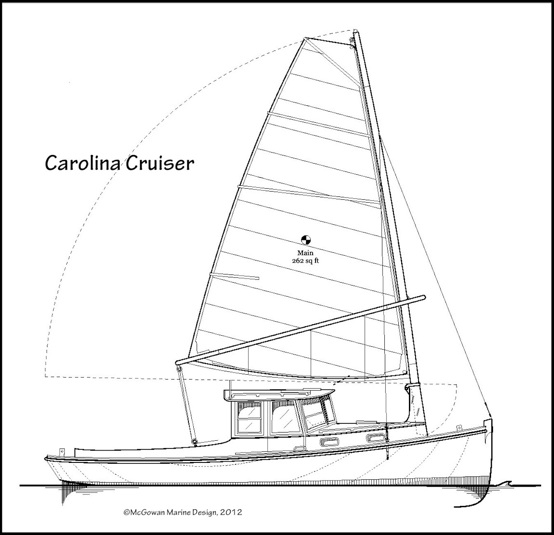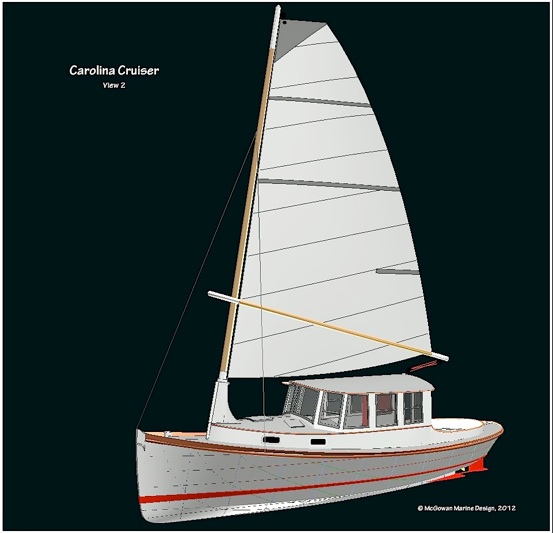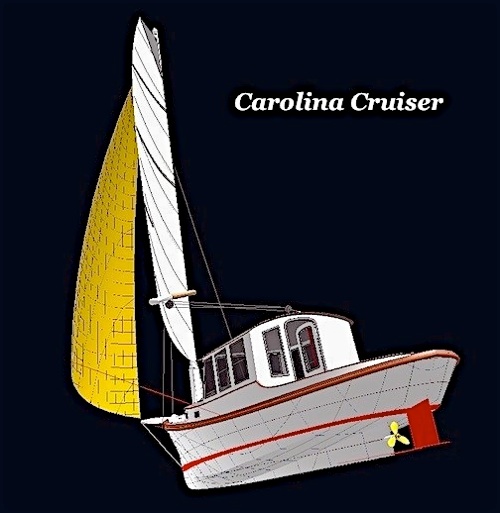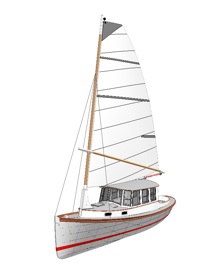
Copyright 2001-2021 inclusive McGowan Marine Design, Inc.
Accommodations are simple: vee berth forward, head and galley aft of that (starboard and port), then a simple wheelhouse with stove, pilot and co-pilot seats, and perhaps a settee. There is full standing headroom throughout. The client prefers the simplicity of the short wheelhouse, but the longer wheelhouse version could feature a good closet, dinette, and perhaps have the galley up there, too.
This preliminary design was commissioned by a former Egret Sharpie owner who wanted a simple, shallow-draft motorsailer for cruising around the interesting coasts of North Carolina, and up as many creeks as possible. Inspiration for the design came from work boats of the Carolinas and also from the boatbuilding books of Harry Sucher and Howard Chapelle. (There’s some Nova Scotia workboat in there too, if you look closely)
The plywood hull is somewhat wherry-like, and with an almost tugboat stern. I was careful to refine it a few times so the stern doesn’t look like a duck with diapers - which can happen when designing these things. Water flow to the prop on a nearly-horizontal shaft is very good. The engine would be a simple 20-30hp diesel, though we looked at an all-electric setup (with solar panels and wind generator aft) - an arrangement I’m partial to. Simplicity and up-front cost won out, so diesel it is.
33’ Carolina Cruiser - a tradition-inspired motorsailer

The simple but efficient folding rig will help with going under bridges. To drop the mast a pin would get pulled at its base, the forestay would be let out a few feet (using tackle), then a block and tackle would be attached to the then-exposed mast base and an eye on the deck. From the foredeck the mast would be lowered into a folding gallows aft. Raising the mast would be accomplished by reversing this operation.
The rig would also include a reaching gennaker flown off a reefing or swinging bowsprit. All halyards lead to the aluminum tabernacle and the mainsheet leads to either the cockpit or the sliding door on the starboard (helm) side of the wheelhouse.
The winged keel and rudder (‘glass plates, really) are used to counter leeway that comes with a shallow hull, and to help balance sail pressures for good steering. (More lateral plane is needed aft in shallow designs because the centre of lateral plane is relatively far forward in them, and plates accomplish this without making the boat deeper.)

This boat would also be very good for cruising the Eastern Seaboard, the Caribbean, and the Great Circle (up the East Coast, up the St. Lawrence River, through the great lakes to the Mississippi, down that river, then around the tip of Florida) - or through the many canals of Europe and the British Isles.
A small movie showing the hull, rig, and longer wheelhouse version.
With Reaching Gennaker


Particulars
LOA - 32'- 11 1/2"
LWL - 29'- 6 3/8"
Beam - 10'- 5"
Draft - 1'- 10 1/8"
Displacement - 11,460 lbs.
D/L - 198
Sail Area - 390 sq. ft.
Construction - strip planking, plywood, epoxy/'glass
Motor - 20-30 hp diesel
Designed with TouchCad

